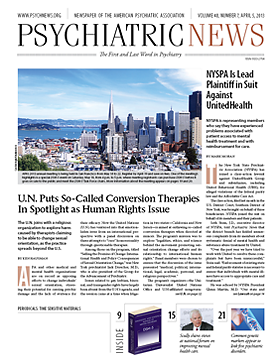Gender dysphoria is a new diagnostic class in DSM-5—and a chapter unto itself—replacing the DSM-IV diagnosis of gender identity disorder and reflecting a new conceptualization of individuals who seek treatment for problems related to gender.
Criteria for the new category emphasize the phenomenon of “gender incongruence” rather than cross-gender identification, as was the case in DSM-IV. By separating it from sexual dysfunctions and paraphilias (with which it had previously been included in DSM-IV in a chapter titled “Sex and Gender Identity Disorders”), work group members said they hope to diminish stigma attached to a unique diagnosis that is used by mental health professionals but for which treatment often involves endocrinologists, surgeons, and other professionals.
(The chapter devoted to gender dysphoria follows the chapter titled “Sexual Dysfunctions.” That chapter is marked by the addition of gender-specific sexual dysfunctions and the combination of female sexual desire and arousal disorders into a new disorder, female sexual interest/arousal disorder. Additionally, the paraphillic disorders that had previously appeared with gender identity disorder (GID) in the DSM-IV chapter titled “Sex and Gender Identity Disorders” have been split off into a separate chapter that appears later in the manual. And to improve precision regarding duration and severity and to reduce the likelihood of overdiagnosis, all of the DSM-5 sexual dysfunctions except substance-/medication-induced sexual dysfunction now require a minimum duration of approximately six months.)
Meanwhile, refinements to intermittent explosive disorder, conduct disorder, and oppositional defiant disorder mark the major changes to the chapter titled “Disruptive, Impulse-Control, and Conduct Disorders.” The chapter, bringing together disorders marked by problems in emotional and behavioral self-control, combines disorders previously classified in DSM-IV under disorders of infancy, childhood, and adolescence, along with other impulse control disorders—pyromania and kleptomania—not confined by age.
The three chapters—”Sexual Dysfunctions,” “Gender Dysphoria,” and “Disruptive, Impulse-Control and Conduct Disorders”—are the 12th, 13th, and 14th chapters that will appear in Section II of DSM-5, to be published in May. While the new manual includes much that is familiar, important differences—not only in criteria for individual disorders, but in the organization of the text—will be readily apparent. The changes reflect an effort begun more than a decade ago to respond to challenges posed by research and clinical experience to previous editions of the manual including high rates of comorbidity within and across DSM chapters, an excessive use of and reliance on “not otherwise specified” (NOS) criteria, and a growing inability to integrate DSM disorders with the findings from genetic and other research.
Some of the overarching conceptual ideas that have informed the development of diagnostic criteria and the organization of the text include incorporation of a developmental approach to psychiatric disorders, recognition of the influence of culture and gender on how psychiatric illness presents in individual patients, a move toward the use of dimensional measures to rate severity and disaggregate symptoms that tend to occur across multiple disorders, harmonization of the text with ICD, and integration of genetic and neurobiological findings by grouping clusters of disorders that share genetic or neurobiological substrates.
DSM-5 consists of three sections: Section I gives an introduction to DSM-5 with instructions on how to use the manual; Section II outlines the categorical diagnoses according to a revised chapter organization that eliminates the multiaxial system; and Section III includes conditions that require further research before their consideration as formal diagnoses, as well as cultural formulations and other information.
Jack Drescher, M.D., a member of a subgroup that helped formulate criteria for gender dysphoria, explained that a central tension in discussions about the diagnosis was between the possibly stigmatizing effect of retaining a category for gender conflicts among a list of mental disorders and the need to maintain access to care for individuals who do experience distress or impairment in function with regard to gender conflicts.
“We decided the access-to-care issue was very important,” Drescher told Psychiatric News. “If you take out the diagnosis, you don’t have a code for treatment.”
But Drescher said the removal of the diagnosis from the chapter including sexual dysfunctions—and the separation of paraphillic disorders into its own chapter in DSM-5—should serve to lessen stigma associated with the diagnosis. Also, he said the name change to “gender dysphoria” is an effort to reflect the individual’s felt sense of incongruence with natal gender, as opposed to pathologizing gender-atypical behavior.
Drescher said the category is reconceptualized as one diagnosis with separate developmentally appropriate criteria sets for children and for adolescents and adults.
For both groups, the criteria include a specifier to indicate whether the individual’s condition is related to a disorder of sex development (DSD) such as congenital adrenal hyperplasia; this is in contrast to DSM-IV in which the presence of a DSD or intersex condition was an exclusionary criterion for the diagnosis of GID.
The criteria for adolescents and adults also include a specifier to indicate whether the individual has transitioned to full-time living in the desired gender.
And for children, Criterion A1 (“a strong desire to be of the other gender or an insistence that he or she is the other gender…)” is now necessary but not sufficient to meet the diagnosis, which makes the diagnosis more restrictive and conservative.
“It’s really a narrowing of the criteria because you have to want the diagnosis,” Drescher said. “It takes psychiatrists out of the business of labeling children or others simply because they show gender-atypical behavior.” ■
